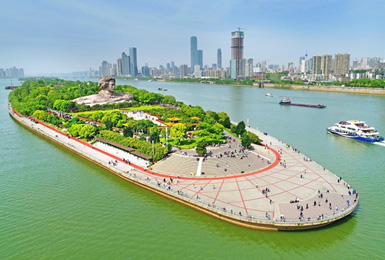Photo source: hunan.gov.cn
Hunan has an extensive network of rivers. To the north is the Dongting Lake, the second largest freshwater lake in China. It has the largest reserve of natural water resources among the nine provinces of southern China.
Its cultivated land, pastureland, and forests total 3.78 million ha., 6.37 million ha., and 10.3699 million ha., respectively forming approximately 3 percent, 1.6 percent and 6.6 percent of the country’s totals. The province has rich and varied land resources, favoring the development of its agriculture, forestry, animal husbandry and fisheries.
It is rich in both nonferrous and non-metallic minerals. A total of 141 minerals have been identified in the province; 60 of these represent deposits that place them among the country’s top ten mineral reserves, especially the nonferrous metals. Hunan’s abundant mineral reserves highlight its importance not only to the country but to the wider world.
Hunan has rich resources of animals and plants with a wide coverage. Five rare surviving "living fossil" in the world are found in Hunan, namely: Cathaya Aargyrophylla, Met sequoia Glyptostrobodies, Glyptostrobus Pensilis, Gingko and Davidia Involucrate.
There are around 5,000 types of seed plants, taking the seventh place across the country, over 2,000 kinds of woody plants, more than 1,000 types of wild economic plants, over 800 sorts of medicinal plants and 66 categories of rare wild plants under state protection. Grain crops are rich in category, with over 9,000 types of rice. Oil crops include camellia oleosa seed, seed of tung tree, rapeseed, sesame, sunflower, cottonseed and castor-oil plant. Economic crops are mainly cotton, ramie, jute (red jute) and tobacco. There are 100 types of medicinal plants like coptisroot and gastrodia elata and 88 sorts of agricultural and sideline products including citrus, tea, Hunan white lotus, day lily, water-soaked bamboo slice, lilium brownii var. viridulum, pearl barley and hot pepper.
There are woody plants of 103 families, 478 genera and 2, 470 species. Hunan's forest area has reached 7.5,014 million hectares, with forest coverage of 51.4%, higher than the national and world level. 23 forest natural reserves have been established, and the first national forest park Zhangjiajie Forest Park is among them.
The provincial grassland area covers 6.373 million hectares, among which available grassland reaches 5.666 million hectares. The grazing capacity achieves 7,040 thousand cattle unit. There are grassland plants of 137 families and 868 species, among which 775 species serve as the food of livestock.
Hunan has a great variety of animals. There are 66 kinds of wild mammals, over 500 sorts of birds, 71 kinds of reptiles, 40 types of amphibians, more than 1,000 sorts of insects and over 200 kinds of aquatic animals. There are 18 categories of animals under the first-class state protection like south China tiger, clouded leopard, golden cat, whitecrane and white-flag dolphin, 28 sorts of animals included in the second-class such as macaque, stump-tailed macaque, pangolin, hellbender and cowfish, and 49 types of animals belonging to the third-class including egret, wild duck and bamboo partridge. As the well-known freshwater fish producing area in China, Hunan has over 160 types of natural fish, including carp, blackcarp, grass carp, bighead carp, silver carp, bream fish, crucian carp, gurnet, which mainly belong to the cyprinidae family. Famous species are Chinese sturgeon, Chinese paddlefish, silverfish, hilsa herring and eel. Regarding livestock and poultry, Ningxiang pig, Binhu buffalo, Xiangxi cattle, Xiangdong black goat, Wugang bronze goose, Linwu duck and Liuyang three buff chickens are the most well-known.
Chinese source: hunan.gov.cn


